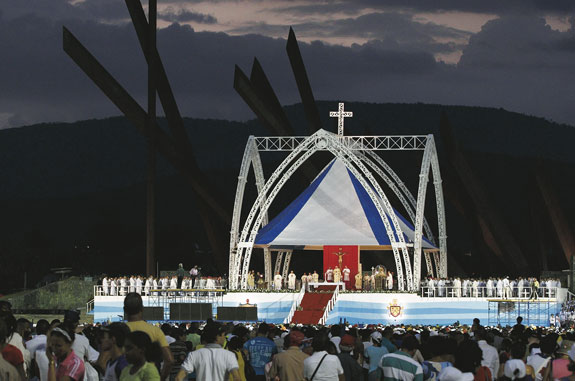by Patricia Zapor

WASHINGTON (CNS) – The president of the Cuban bishops’ conference told a group of Cuban emigrants and other Americans of plans to build one of the country’s first new churches in 50 years in his archdiocese, using materials salvaged from the stage built for a Mass there celebrated by Pope Benedict XVI two years ago.
Archbishop Dionisio Garcia Ibanez of Santiago de Cuba described his trip to Miami, New York and Washington, D.C., as a pastoral visit to keep in touch with Cuban emigrants and to solicit support for projects at home, including the new church in Santiago.
In the more than 50 years since the Cuban revolution, government permission has been necessary for any church construction, even to renovate existing church buildings. The opening of a new seminary complex in Havana in 2010 was the first major church-building project in 40 years. In the early years after Fidel Castro became president, church properties of all sorts were confiscated by the government and turned to other uses.
Since then, Catholics and people of other faiths have developed networks of “house churches” that gather in individual homes where there are not proper church buildings available.
Archbishop Garcia said the new church in Santiago will serve a neighborhood with tens of thousands of people and no church. “But this is a special case,” he said, in that it will commemorate Pope Benedict’s trip to Santiago in March, 2012.
Archbishop Garcia was being hosted by Archbishop Carlo Maria Vigano, apostolic nuncio to the U.S., for a reception at the nunciature in Washington.
The Cuban archbishop told CNS the evening was partly to raise funds for a U.S.-based foundation that supports the church in Cuba, particularly its Shrine of Our Lady of Charity of El Cobre in the Santiago Archdiocese, and partly to renew ties with the local community of Cuban-Americans.
“We are all united in one church,” said the archbishop, who often refers to one Catholic Church of Cuba, with some parts of the community living in the island nation and some living in North America.
In introducing Archbishop Garcia at the reception, Brooklyn Auxiliary Bishop Octavio Cisneros, who heads the Our Lady of Charity of Cobre Foundation, likened the Cuban’s mission to that of St. Francis of Assisi. St. Francis first felt he had a call from God to “rebuild my church” and took it literally, repairing a deteriorated chapel. He then came to see that call as about rebuilding the church’s human structures.
“Pope Francis, Archbishop Dionisio, and all of us Cubans have been rebuilding the church,” in a variety of ways, he said.
Archbishop Garcia told the guests that, little by little, the Cuban government has been allowing the church to repair and upgrade its buildings.
“They’ve not only allowed Catholics to rebuild but also the Protestants,” he added. “This is good.”
